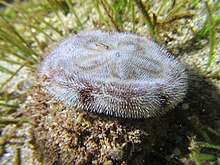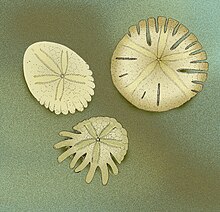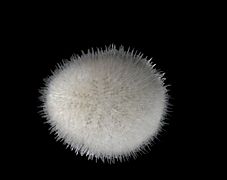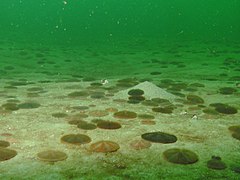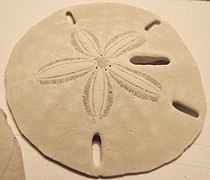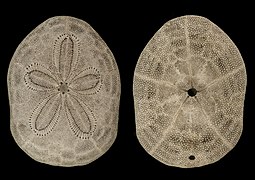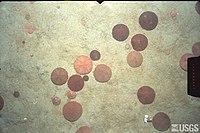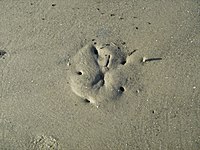
An echinoderm is any deuterostomal animal of the phylum Echinodermata, which includes starfish, brittle stars, sea urchins, sand dollars and sea cucumbers, as well as the sessile sea lilies or "stone lilies". While bilaterally symmetrical as larvae, as adults echinoderms are recognisable by their usually five-pointed radial symmetry, and are found on the sea bed at every ocean depth from the intertidal zone to the abyssal zone. The phylum contains about 7,000 living species, making it the second-largest group of deuterostomes after the chordates, as well as the largest marine-only phylum. The first definitive echinoderms appeared near the start of the Cambrian.

Sea urchins are spiny, globular echinoderms in the class Echinoidea. About 950 species of sea urchin are distributed on the seabeds of every ocean and inhabit every depth zone from the intertidal seashore down to 5,000 meters. The spherical, hard shells (tests) of sea urchins are round and covered in spines. Most urchin spines range in length from 3 to 10 cm, with outliers such as the black sea urchin possessing spines as long as 30 cm (12 in). Sea urchins move slowly, crawling with tube feet, and also propel themselves with their spines. Although algae are the primary diet, sea urchins also eat slow-moving (sessile) animals. Predators that eat sea urchins include a wide variety of fish, starfish, crabs, marine mammals, and humans.

The diadema urchin or blue-black urchin is a species of tropical sea urchin, member of the Diadematidae family.
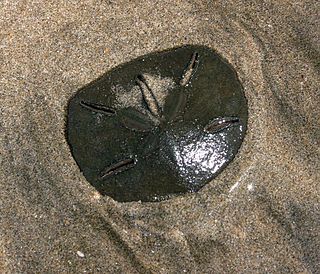
Keyhole sand dollar refers to three species of sand dollars in the genus Mellita. They are found on the Atlantic coasts of the Americas, ranging from Caribbean Islands, such as Jamaica and Puerto Rico, to the southern areas of the United States at the north to the southern coasts of Brazil at the south. Their range includes Bermuda and the Pacific coasts of equatorial countries, such as Mexico and Costa Rica also found in Honduras.

Meoma ventricosa, known by the common names cake urchin and red heart urchin, is a large species of sea urchin which lives in shallow waters in the Caribbean. It may reach a diameter of twenty centimeters and is covered in reddish-brown spines. It has both pentagonal radial symmetry and bilateral symmetry, giving it a sand-dollar appearance; however, two of its five sections are merged more closely than the others.

Dendraster excentricus, also known as the eccentric sand dollar, sea-cake, biscuit-urchin, western sand dollar, or Pacific sand dollar, is a species of sand dollar in the family Dendrasteridae. It is a flattened, burrowing sea urchin found in the north-eastern Pacific Ocean from Alaska to Baja California.

Echinometra mathaei, the burrowing urchin, is a species of sea urchin in the family Echinometridae. It occurs in shallow waters in the Indo-Pacific region. The type locality is Mauritius.
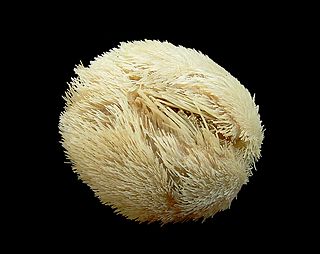
Echinocardium cordatum, also known as the common heart urchin or the sea potato, is a sea urchin in the family Loveniidae. It is found in sub-tidal regions in temperate seas throughout the world. It lives buried in the sandy sea floor.

Clypeaster, common name "cake urchins" or "sea biscuits", is a genus of echinoderms belonging to the family Clypeasteridae.
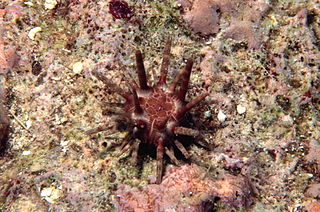
Eucidaris metularia, the ten-lined urchin, is a species of sea urchins in the family Cidaridae. It is found in shallow parts of the Indo-Pacific Ocean and is characterised by its sparse covering of banded, flat-tipped spines.

Clypeaster australasiae, the Australasian sand dollar, is a species of sea urchins of the family Clypeasteridae. Their armour is covered with spines. Clypeaster australasiae was first scientifically described in 1851 by Gray.

Heliophora orbicularis, also known as the West African Sand Dollar, is a small sand dollar in to the family Rotulidae, and the only species in the genus Heliophora. It, and other members of Rotulidae have been found in West African marine strata from the Late Miocene onward. Like the related Rotula, it is still extant.

Irregularia is an extant infraclass of sea urchins that first appeared in the Lower Jurassic.
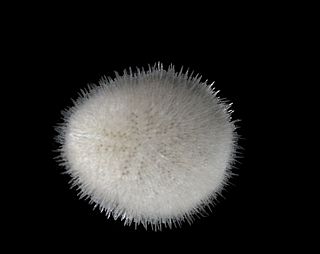
The Neognathostomata are a superorder of sea urchins.

Clypeaster reticulatus, the reticulated sea biscuit, is a species of sea urchin in the family Clypeasteridae. This species was first scientifically described in 1758 by Carl Linnaeus. It lives on the sandy seabed of shallow seas, semi-immersed in the sediment.

Clypeasteridae is a family of sea urchins in the order Clypeasteroida. This family was first scientifically described in 1835 by the Swiss-American biologist Louis Agassiz.

Clypeaster rosaceus, the fat sea biscuit, is a species of sea urchin in the family Clypeasteridae. It occurs in shallow water in the western Atlantic Ocean and was first scientifically described in 1758 by Carl Linnaeus.

Clypeaster japonicus, the Japanese sea biscuit, is a species of sea urchin in the family Clypeasteridae. This species was first scientifically described in 1885 by the German zoologist Ludwig Heinrich Philipp Döderlein.

Leodia sexiesperforata, commonly known as the six-holed keyhole urchin, is a species of sand dollar, in the echinoderm order Clypeasteroida. It is native to tropical and sub-tropical parts of the western Atlantic Ocean where it buries itself in soft sediment in shallow seas.

Mellitidae is a family of sand dollars, in the echinoderm order Clypeasteroida. These irregular sea urchins bury themselves in soft sediment in shallow seas.
